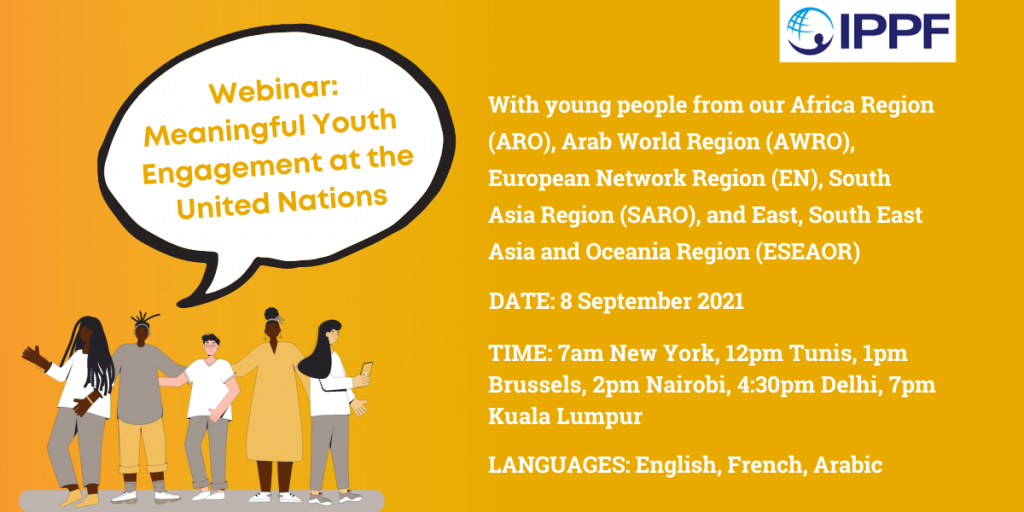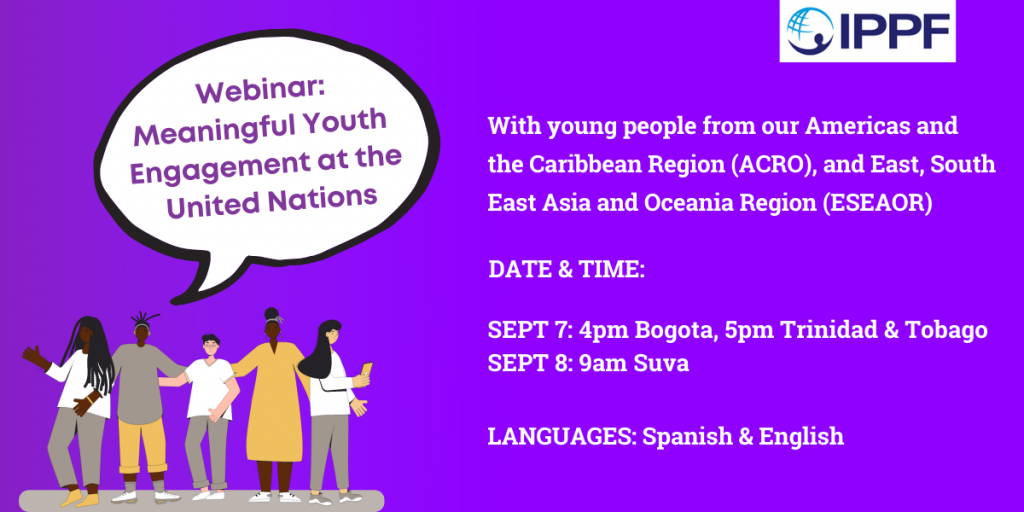


Join our Webinars on the 7th and 8th September:
Meaningful Youth Engagement at the United Nations
Introduction
IPPF’s intergovernmental work compromises of continuous presence at the UN in both New York and Geneva, covering annual negotiation processes on resolutions and other outcome documents that are key to our work on gender, health, youth, and human rights. Alongside this coordinated UN work, IPPF’s presence through Member Associations and Collaborating Partners in more than 140 countries allows IPPF inputs into these resolutions with priorities and key messages informed by those most impacted at the national level. This provides IPPF with the ability to mobilize and build capacity amongst Member Associations to ensure that SRHR remains high on their governments’ agenda at national level and to support MA advocacy to hold their governments accountable for their commitments and to ensure their representatives in New York and Geneva are accurately representing national priorities on gender and SRHR.
To inform IPPF priorities and key messages, it is essential to hear from MAs and directly impacted communities about what they consider to be the most critical issues to be addressed in their contexts and their recommendations for government actions. These can then be passed on to government delegates in UN spaces by IPPF representatives in New York and Geneva. For resolutions relating to youth, it is vital that we hear from youth activists and MA youth networks about the challenges they and their peers face on an everyday basis to access sexual and reproductive health services and exercise their sexual and reproductive rights, as well as their recommendations on how governments can best meet their needs. This allows IPPF to advocate with Member States at the UN to prioritize these challenges, recommendations and opportunities when the resolutions on youth are being negotiated. It also allows IPPF to share the final resolutions with the youth so they can mobilize at the national and community level to hold their governments accountable for implement the resolutions once they are adopted.
In addition to including priorities and recommendations in the negotiation process, it is very important for IPPF UN Liaison representatives to meet with young people so they can include them in all relevant aspects of their work and mainstream youth voices and priorities across UN advocacy. Engagement with young people also offers the opportunity to build capacity for young people to engage in UN spaces directly and through national advocacy, through IPPF support. This is particularly important because youth voices are often systematically excluded and marginalized from intergovernmental spaces. Where youth are given spaces to organize, it is usually divorced from the main event and kept separate. Youth voices are mostly included only on topics limited to youth, rather than mainstreamed throughout UN processes, and are often tokenistic and more of a checklist exercise. By mainstreaming youth priorities through IPPF UN work and building young people’s capacity to engage themselves directly, IPPF can support young advocates to speak for themselves and to participate more holistically in UN advocacy, especially on topics they prioritize.
Background on youth resolutions in New York and Geneva
- New York – UN General Assembly Resolution
The Resolution on Policies and Programmes involving Youth is a biannual resolution presented in the UN General Assembly Third Committee under Agenda 25 (b) on Social development, including questions relating to the world social situation and to youth, ageing, disabled persons and the family. This resolution seeks to address issues related to young people worldwide by reaffirming Governments’ commitments to fulfill the human rights and the well-being of young people. The text refers to the World Programme of Action for Youth, adopted in 1995 as a milestone and to the 2030 Agenda for Sustainable development as an opportunity to do even more regarding policies and programmes involving young people. With the largest generation of young people in history in the world, the text seeks to be the basis for action and policies at national, regional and international levels. Currently, the main sponsors of the resolution are Portugal, Kazakhstan, and Cabo Verde.
The 2019 resolution was adopted by consensus and recognized for the first time that young women between the ages of 15 and 24 are most vulnerable to HIV. The text also contains new language on the mental health of young people, the role of youth in preserving cultural heritage and the prevention of cyberstalking and cyberbullying. Some of the most notable gains include:
- A new paragraph on the critical need to achieve human rights, needs, and well-being of young people to achieve the 2030 Agenda, the Vienna Declaration and Programme of Action, the Programme of Action of the International Conference on Population and Development and the Beijing Declaration and Platform for Action, and their review conferences (PP5),
- Another new paragraph (PP13) with language on universal health coverage moves the resolution a step forward by establishing the link between young people’s good health and well-being and their capacity and opportunities in education and employment,
- A new and important element to the text is the paragraph recognizing women between 15 and 24 as most vulnerable to HIV (PP14) which underlines the gendered aspects of the epidemic and accordingly the need for targeted and urgent policies and youth-friendly programs on SRH and CSE for adolescents specifically,
- Another important new element is the update on the paragraph on the Lisbon Declaration on Youth Policies and Programmes (PP21) which included a reference to the II World Conference of Ministers Responsible for Youth and Youth Forum Lisboa+21 and the Declaration on Youth Policies and Programmes,
- The operative section includes a new paragraph on the importance of protecting, promoting, and fulfilling the realization of the human rights of young people (OP5),
- The text also includes a new paragraph with reference to violence against girls and young women, including sexual harassment, and the Declaration on the Elimination of Violence against Women. This also marks a step forward setting a positive precedent for future resolutions.
This resolution is important in setting international standards on issues, policies and programs involving youth. It also serves as a basis towards the need for governments’ response to sexual and reproductive needs and issues of young people – provide gender transformative comprehensive sexuality education, provide youth-centered services, respond to special needs of marginalized young people such as young gay, lesbian, trans, intersex and queer people across other vulnerabilities such as sexual and gender-based violence, poverty, disability or problems of accessibility.
- Geneva
The Human Rights Council resolution on Youth and Human Rights is presented by a core group of countries: Cote d’Ivoire, Egypt, El Salvador, France, Greece, Italy, Morocco, Philippines, Portugal, Republic of Moldova, and Tunisia. It was negotiated in 2016, 2017, and 2019, when it was decided to be a triannual resolution. It has previously been a fairly short and straightforward resolution, recognizing the role youth can play in peace, human rights and sustainable development and calling for panel discussions or reports from OHCHR.
In 2019, the text emphasized the rights of young people and the importance of their participation in decision making processes at all levels. It welcomed the World Conference of Ministers Responsible for Youth in Lisbon and took note of its Declaration on Youth Policies and Programmes (which includes language on Sexual and Reproductive Health and Rights (SRHR) and CSE). The 2019 resolution called on OHCHR to organize a seminar in 2020 focused on the challenges and opportunities of young people in the field of human rights, with the participation and involvement of youth-led and youth focused organizations, and report back before the March session in 2021. Due to the coronavirus pandemic, this was postponed until 2021, and took place in April 2021 (read more about this here).
The upcoming Youth and Human Rights resolution was supposed to be presented in June, but is postponed until the OHCHR report on the April seminar is published in 2022. However, an understanding of the priorities for young people in the IPPF community will inform IPPF work at the Human Rights Council in general and allow IPPF to prepare in advance for the youth resolution in 2022.
Objectives of the webinar
- Increase young people’s knowledge on the UN System and its mechanisms, and the ongoing discussion regarding the UN Resolutions
- To amplify young people’s voices at the UN on SRHR
- Develop a long-term strategy between youth and advocacy team on young people’s meaningful engagement at the UN
There will be two webinars to accommodate the different time zones between the IPPF regional offices.
Agenda
8th September, 2021; 1pm – Brussels; 4:30pm – New Delhi; 7pm – Kuala Lumpur; 7am New York; 2pm – Nairobi
Meeting link:
ESEAOR, ENRO, AWRO, ARO, SARO
| Time | Session | Facilitator |
| 5 mins | Introduction | Brayant Gonzales, Senior Programme Officer, Youth and SRHR Programme. |
| 45Mins | -What are the United Nations – Advocacy at the United Nations – What role does it play? – Why is it important? – The link between the international, regional and national level advocacy | Estelle Wagner, International Advocacy Adviser, IPPF |
| 15 mins | Question and answer session | Nofundo Baphelele Masilela – Youth Action Movement ( YAM ) |
| 40 mins | UN Resolutions -Background of the UN resolutions -UN Youth resolutions – Content discussion – How youth can engage | Selamawit Tesfaye, Senior Advocacy Advisor, IPPF |
| 15 mins | Youth and Meaningful engagement in advocacy | Anita Nyanjong, Global Lead, Youth, IPPF |
| 20 mins | Young people’s experiences in advocacy | Amanda Filipsson – YSAFE |
| 20 mins | Q and A | Amour dieu-donné Vodounhessi – Youth Action Movement ( YAM ) |
| 10 mins | Conclusion and recommendations | Angela Tatua, IPPF Youth Advisor, ARO |